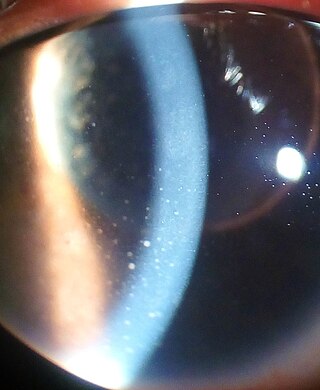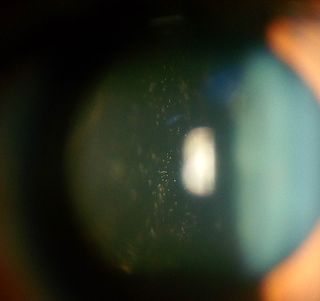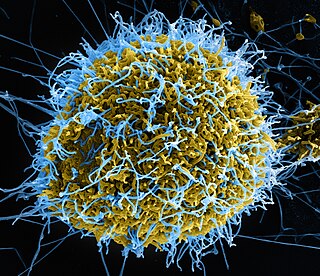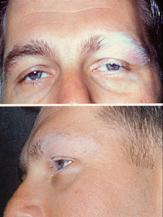Related Research Articles

Chorioretinitis is an inflammation of the choroid and retina of the eye. It is a form of posterior uveitis. Inflammation of these layers can lead to vision-threatening complications. If only the choroid is inflamed, not the retina, the condition is termed choroiditis. The ophthalmologist's goal in treating these potentially blinding conditions is to eliminate the inflammation and minimize the potential risk of therapy to the patient.
The National Eye Institute (NEI) is part of the U.S. National Institutes of Health (NIH), an agency of the U.S. Department of Health and Human Services. The mission of NEI is "to eliminate vision loss and improve quality of life through vision research." NEI consists of two major branches for research: an extramural branch that funds studies outside NIH and an intramural branch that funds research on the NIH campus in Bethesda, Maryland. Most of the NEI budget funds extramural research.

Uveitis is inflammation of the uvea, the pigmented layer of the eye between the inner retina and the outer fibrous layer composed of the sclera and cornea. The uvea consists of the middle layer of pigmented vascular structures of the eye and includes the iris, ciliary body, and choroid. Uveitis is described anatomically, by the part of the eye affected, as anterior, intermediate or posterior, or panuveitic if all parts are involved. Anterior uveitis (iridocyclitis) is the most common, with the incidence of uveitis overall affecting approximately 1:4500, most commonly those between the ages of 20–60. Symptoms include eye pain, eye redness, floaters and blurred vision, and ophthalmic examination may show dilated ciliary blood vessels and the presence of cells in the anterior chamber. Uveitis may arise spontaneously, have a genetic component, or be associated with an autoimmune disease or infection. While the eye is a relatively protected environment, its immune mechanisms may be overcome resulting in inflammation and tissue destruction associated with T-cell activation.

Difluprednate, sold under the brand name Durezol, is a corticosteroid used for the treatment of post-operative ocular inflammation and pain.
Intraocular lymphoma is a rare malignant form of eye cancer. Intraocular lymphoma may affect the eye secondarily from a metastasis from a non-ocular tumor or may arise within the eye primarily. PIOL is a subset of primary central nervous system lymphoma (PCNSL). PCNSL are most commonly a diffuse large B-cell immunohistologic subtype of non-Hodgkin's lymphoma according to the World Health Organization (WHO) classification of lymphomas. The most common symptoms of PIOL include blurred or decreased vision due to tumor cells in the vitreous. Most cases of PIOL eventuate to central nervous system involvement (PCNSL) while only 20% of PCNSL lead to intraocular (PIOL) involvement. PIOL and PCNSL remain enigmas because both structures are immunologically privileged sites and so do not normally have immune cells trafficking through these structures. What is more, while the vast majority of PCNSL in patients with acquired immune deficiency syndrome (AIDS) is related to the Epstein-Barr virus (EBV), the development of PCNSL and PIOL in immunocompetent patients is unknown and shows no general relation to infectious DNAs.

Intermediate uveitis is a form of uveitis localized to the vitreous and peripheral retina. Primary sites of inflammation include the vitreous of which other such entities as pars planitis, posterior cyclitis, and hyalitis are encompassed. Intermediate uveitis may either be an isolated eye disease or associated with the development of a systemic disease such as multiple sclerosis or sarcoidosis. As such, intermediate uveitis may be the first expression of a systemic condition. Infectious causes of intermediate uveitis include Epstein–Barr virus infection, Lyme disease, HTLV-1 virus infection, cat scratch disease, and hepatitis C.

New York Eye and Ear Infirmary of Mount Sinai (NYEE) is located at East 14th Street and Second Avenue in lower Manhattan, New York City. Founded on August 14, 1820, NYEE is America's first specialty hospital and one of the most prominent in the fields of ophthalmology and otolaryngology in the world, providing primary inpatient and outpatient care in those specialties. Previously affiliated with New York Medical College, as of 2013 it is affiliated with the Icahn School of Medicine at Mount Sinai as a part of the membership in the Mount Sinai Health System.
Douglas Jabs is an American ophthalmologist and an expert in clinical research in the fields of ophthalmology and uveitis.

Idiopathic orbital inflammatory (IOI) disease refers to a marginated mass-like enhancing soft tissue involving any area of the orbit. It is the most common painful orbital mass in the adult population, and is associated with proptosis, cranial nerve palsy, uveitis, and retinal detachment. Idiopathic orbital inflammatory syndrome, also known as orbital pseudotumor, was first described by Gleason in 1903 and by Busse and Hochheim. It was then characterized as a distinct entity in 1905 by Birch-Hirschfeld. It is a benign, nongranulomatous orbital inflammatory process characterized by extraocular orbital and adnexal inflammation with no known local or systemic cause. Its diagnosis is of exclusion once neoplasm, primary infection and systemic disorders have been ruled out. Once diagnosed, it is characterized by its chronicity, anatomic location or histologic subtype.

Orbital lymphoma is a common type of non-Hodgkin lymphoma that occurs near or on the eye. Common symptoms include decreased vision and uveitis. Orbital lymphoma can be diagnosed via a biopsy of the eye and is usually treated with radiotherapy or in combination with chemotherapy.
James T. Rosenbaum is an American physician-scientist who is Senior Vice President for Research at Corvus Pharmaceuticals and Chief of Ophthalmology emeritus at the Legacy Devers Eye Institute, Portland, Oregon, where he held the Richard Chenoweth Chair. Previously, he was Chief of Arthritis and Rheumatic Diseases at the Oregon Health & Science University where he held the Edward E Rosenbaum Professorship in Inflammation Research. Rosenbaum was the only practicing rheumatologist/non-ophthalmologist in the world to serve as a chief of ophthalmology. He is recognized for his description of an animal model of uveitis resulting from injection of bacterial endotoxin and for more than 600 scholarly publications, mostly related to the intersection between rheumatology and ophthalmology. He is a co-author of the book, "The Clinical Neurology of Rheumatic Diseases".

Reza Dana is the Claes H. Dohlman Professor of Ophthalmology, senior scientist and W. Clement Stone Clinical Research Scholar at Massachusetts Eye and Ear, Harvard Medical School, and director of the Harvard-Vision Clinical Scientist Development Program.

Post-Ebola virus syndrome is a post-viral syndrome affecting those who have recovered from infection with Ebola. Symptoms include joint and muscle pain, eye problems, including blindness, various neurological problems, and other ailments, sometimes so severe that the person is unable to work. Although similar symptoms had been reported following previous outbreaks in the last 20 years, health professionals began using the term in 2014 when referring to a constellation of symptoms seen in people who had recovered from an acute attack of Ebola disease.

Vogt–Koyanagi–Harada disease (VKH) is a multisystem disease of presumed autoimmune cause that affects melanin-pigmented tissues. The most significant manifestation is bilateral, diffuse uveitis, which affects the eyes. VKH may variably also involve the inner ear, with effects on hearing, the skin, and the meninges of the central nervous system.
Charles Stephen Foster is an American ophthalmologist known for his research and treatment of ocular inflammatory disease (OID) with immunomodulatory therapy. In addition, Foster is the author of approximately 1,000 papers and 14 textbooks. His focus tends to be dedicated to the advancement of ophthalmology. Foster established the Ocular Immunology and Uveitis Foundation to support relevant research. He is currently a mentor and part-time professor of ophthalmology at Harvard Medical School.
ProfessorKeryn Anne Williams is an Australian medical scientist who works in the field of ophthalmology. She was a Principal Research Fellow in the School of Medicine at Flinders University. Her research interests include clinical and experimental corneal transplantation, ocular inflammation, ocular immunology and eye banking.

Sarah Coupland is an Australian-born pathologist and professor who is the George Holt Chair in Pathology at the University of Liverpool. Coupland is an active clinical scientist whose research focuses on the molecular genetics of cancers, with particular interests in uveal melanoma, conjunctival melanoma, intraocular and ocular adnexal lymphomas and CNS lymphoma. Coupland is also an NHS Honorary Consultant Histopathologist at the Royal Liverpool University Hospital. Since 2006, Coupland has been head of the Liverpool Ocular Oncology Research Group; from which she runs a multidisciplinary oncology research group focussing on Uveal melanoma, based in the Department of Molecular and Clinical Cancer Medicine at the University of Liverpool. Her research laboratory is currently located in the Institute of Translational Medicine From April 2014 to December 2019, Coupland was also Director of the North West Cancer Research Centre, @UoL. In both 2019 and 2020, Coupland was included on the 'Pathology Powerlist' on The Pathologist website.

Sub-Tenon injection is an ocular route of drug administration. It involves administration of a medication to the area between the sclera and the Tenon's capsule.

Secondary glaucoma is a collection of progressive optic nerve disorders associated with a rise in intraocular pressure (IOP) which results in the loss of vision. In clinical settings, it is defined as the occurrence of IOP above 21 mmHg requiring the prescription of IOP-managing drugs. It can be broadly divided into two subtypes: secondary open-angle glaucoma and secondary angle-closure glaucoma, depending on the closure of the angle between the cornea and the iris. Principal causes of secondary glaucoma include optic nerve trauma or damage, eye disease, surgery, neovascularization, tumours and use of steroid and sulfa drugs. Risk factors for secondary glaucoma include uveitis, cataract surgery and also intraocular tumours. Common treatments are designed according to the type and the underlying causative condition, in addition to the consequent rise in IOP. These include drug therapy, the use of miotics, surgery or laser therapy.

Uveitic glaucoma is most commonly a progression stage of noninfectious anterior uveitis or iritis.
References
- ↑ "ORCID". orcid.org. Retrieved 2024-07-25.
- ↑ "Kings birthday honours list 2023".
- ↑ Flinders University (2022-11-24). "Forging a positive path for young clinicians". Flinders University Alumni Stories. Retrieved 2024-08-19.
- ↑ IOIS 2023 Scientific Programme. "IOIS Opening Ceremony". www.iois.info. Retrieved 2024-08-21.
{{cite web}}: CS1 maint: numeric names: authors list (link) - ↑ "The Association for Research in Vision and Ophthalmology- 2024 Angle Award: Justine Smith". www.arvo.org. Retrieved 2024-07-25.
- ↑ National Health & Medical Research Council (2024-08-21). "Investigator Grant applications for funding commencing in 2024" (PDF).
- ↑ The Association for Research in Vision and Ophthalmology. "2013 ARVO Fellows". www.arvo.org. Retrieved 2024-08-21.
- 1 2 "ARVO Joanne Angle award 2024".
- ↑ Support, GO Creative (2022-01-28). "Fellowship | AAHMS". aahms.org. Retrieved 2024-07-25.
- ↑ "A-O-INT.org - Academia Ophthalmologica Internationalis | Active Members" . Retrieved 2024-08-21.
- ↑ Academy of Asia-Pacific Professors of Ophthalmology. "Fellows | AAPPO" . Retrieved 2024-08-21.
- ↑ "Professor Justine Smith". Science and Technology Australia. Retrieved 2024-07-25.
- ↑ International Ocular Inflammation Society. "IOIS History - Executive Boards". www.iois.info. Retrieved 2024-08-21.
- ↑ Cartwright, Victoria A.; Smith, Justine R. (2024-03-07). "Women in ophthalmology". Clinical & Experimental Ophthalmology. 52 (2): 133–134. doi:10.1111/ceo.14352. ISSN 1442-6404.